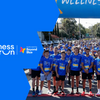Consider These 7 Things Before Buying a Hydration Vest
As your interest in running grows from shiny new obsession to serious hobby, you know that there's more to it than just nice shoes and Strava posts.
The longer you stay on the road or trail, the more gear you need to sustain yourself through those long runs. Not just more gear, but more considered gear. Gear that it best suited to you and your running style.
You need more space to accommodate not only your essentials but, most importantly, your water.
So now you’re weighing your options: is it about time to buy a hydration vest?
Here Are 7 Things to Consider Before Buying a Hydration Vest

With the ability to provide convenience and comfort in carrying water, food, and other essentials during long-distance runs, hydration vests have become a common sight among runners. Made from strong and lightweight materials, these have helped runners enhance their performance, but also stay safer.
However, it is important to note that not all hydration vests are made equal. And these are not cheap, either. Hence, it’s imperative that you consider the different options before pulling the trigger.
Allow us to help you narrow down your choices. Here are the things that you should consider before buying a hydration vest.

One of the primary factors that you have to consider before buying a hydration vest is its purpose. Running vests come in a variety of storage capacities—from 2 liters to 12 or more. Ideally, long runs require more essentials to be brought in preparation for weather adversity and altitude gains. This can include a jacket, trekking poles, headlamps, a thermal survival blanket, gloves, and extra clothing.
Of course, if you're heading out on a local trail, you might just need water, energy gels and your phone.
Hence, before making that purchase, think about the mileage you’re planning to cover and the specific needs you have. As per recommendations, runs that last up to two hours may need at least 2 liters of vest capacity. Running for two to three hours may require 2 to 6 liters. And going further may require up to 4 to 6 or more liters of hydration vest capacity.

After identifying the purpose of your hydration vest (say, knowing what essentials to bring and what distance to cover), it is important to look into its fluid capacity as well. The first one refers to the total volume of goods that the vest can accommodate, while fluid capacity refers to the total amount of liquid it can hold.
In most cases, hydration vests come with a bladder or soft flasks, or a combination of both, just like the RUNLY R700. While the amount of water you carry depends on your consumption, you also have to consider the distance, intensity of the activity, weather conditions, and availability of water sources along the way.

Comfort should never be compromised when choosing a hydration vest. A snug fit is definitely a performance enhancer. You wouldn’t want to experience rubs and chafes that may cause rashes and soreness, right? Totally, unpleasant and distracting.
So before buying that hydration vest, make sure to find one that perfectly fits your body type—one that feels like a second skin. Check for arm mobility and test its stability. Best of all, choose the one that allows you to move freely and breathe without restrictions. Again, always aim for comfort.
Ideally, you want a vest with adaptability like the Runly R700 Hydration Vest which has adjustable chest straps and also adjustable side straps which allow you to tighten or loosen the vest depending on your preferences.

By now, you can probably picture the amount of load you’re going to carry and how it would fit you. This time, we consider its weight. Keep in mind that the more weight you carry, the more energy you use and the more strain you put on your body. For this reason, you have to find a hydration vest that is as light as possible—one that still meets your needs and preferences.
Depending on the materials used, most running vests weigh under a pound. But some are rather heavier because of their overall capacity and design. Therefore, before making that big purchase, always, always learn to 'weigh' up your options.
As time plays a crucial role in running, accessibility to the items inside your hydration vest is very important. Most vests are designed with pockets to hold frequently used items like water, gels, and other essentials.
When buying a hydration vest, make sure to check the positioning of the pockets. Are they easy for you to reach? Would it require you to stop running to grab whatever it is that you need?
Some hydration vests are designed with zippers to secure items, while others rely on elastic mesh for easier access. There are also those that are made with larger rear pockets for bigger items, like bladder, clothes, and nutrition.

Looking at these factors listed, you might wonder what other features you should look into, as most hydration vests come in similar(ish) designs.
Well, know that running vests are not just water carriers; they are also running accessories that can enhance your performance and keep you safe throughout the run.
For one, you can check if it has reflectors that can help you be seen during the night or early morning. If you’re reliant on trekking poles, you can also look into whether it has a dedicated spot at the back or on the sides to secure them. You can also check if the hydration vest comes with a whistle, which is very helpful during emergencies.
Again, this all comes down to two things; understanding the type of running you'll be doing, and what would be suited to you.

Of course, much of this will boil down to an important factor: budget. How much are you willing to spend on your hydration vest?
For beginners, it might be too expensive, but note that this is also an investment on your part. A good hydration vest can take you to wonderful spots and significant mileage without compromising your comfort and safety.
Identifying the ideal price range can help you make a well-informed decision. To make the most of your investment, check once again the hydration vest’s capacity, fit, design, durability, and performance. Make sure to align them all with your needs.
It goes without saying, but you should also take the time to carefully scroll the reviews of the hydration vests in your shortlist. What are other runners saying about it? Do they like it? Is it worth the money?
Of course, like any reviews, there will be outliers - both good and bad, but do your best to get a general overview of the product from the perspective of real people wearing it and using it.
A lot of outdoor brands claim to offer the best hydration vest, of course.
But the best running vest for you is actually the one that syncs with your needs, and your style of running —allowing you to move with ease, chase your goals, and discover the many things that you are capable of.
Invest in a good hydration vest and get ready to unlock your full potential.





